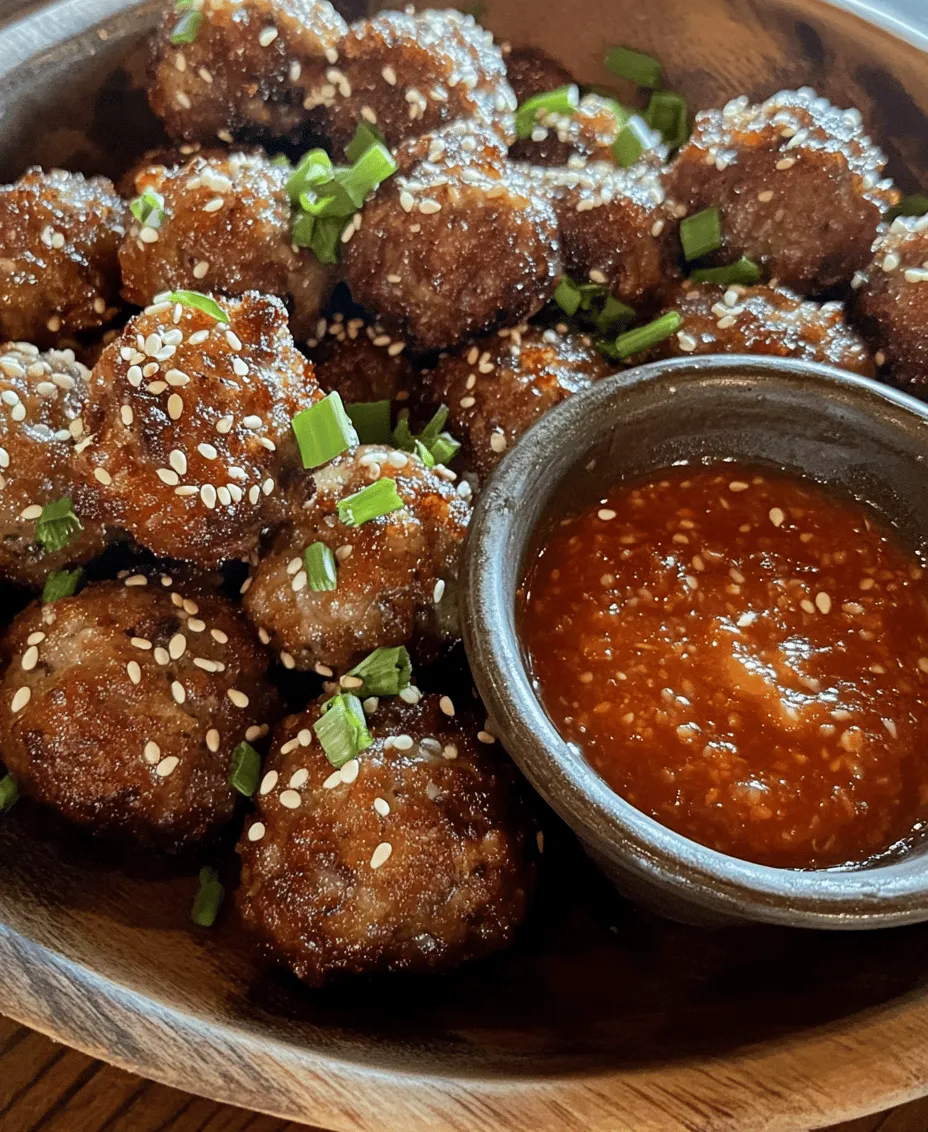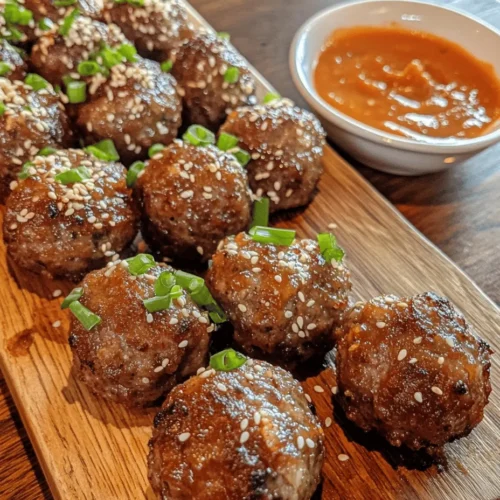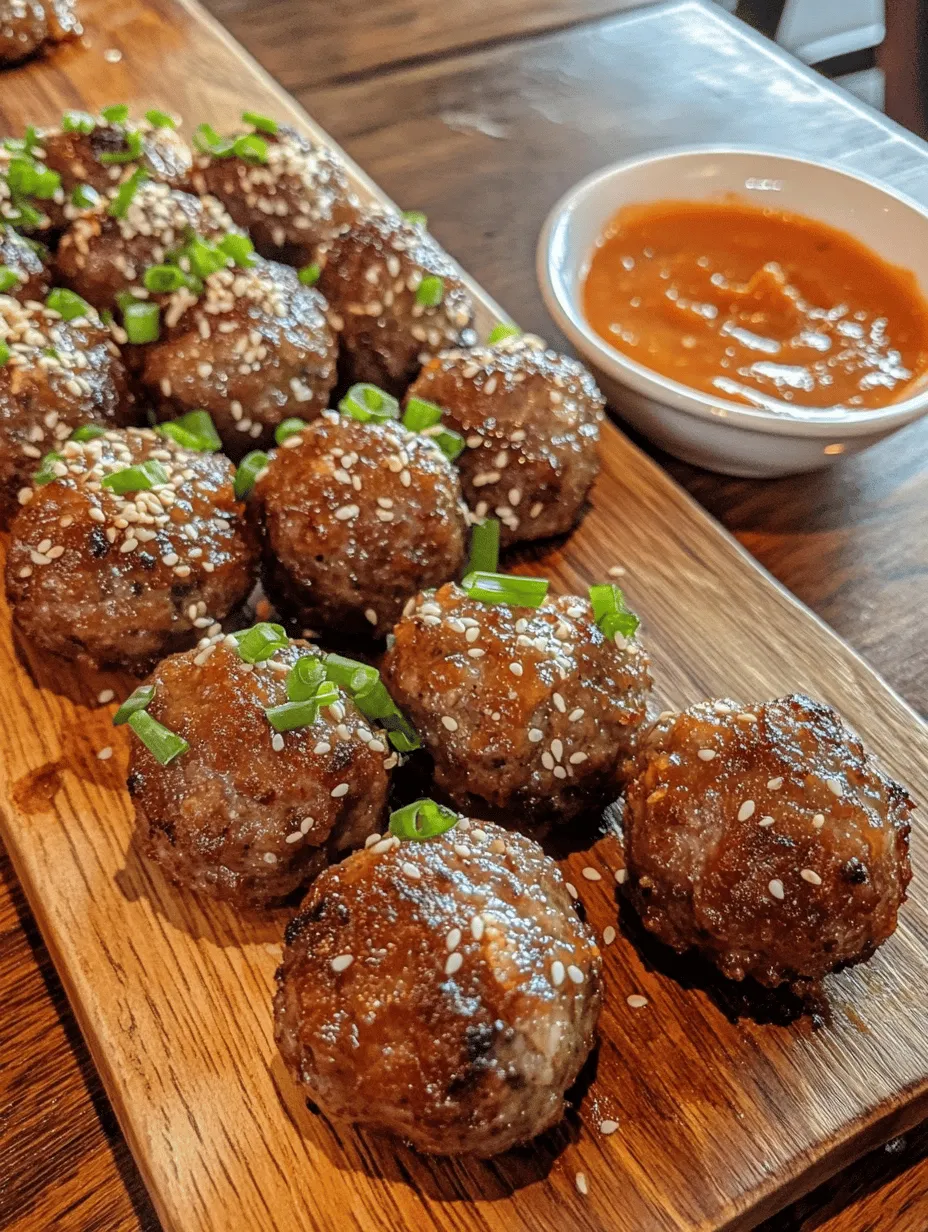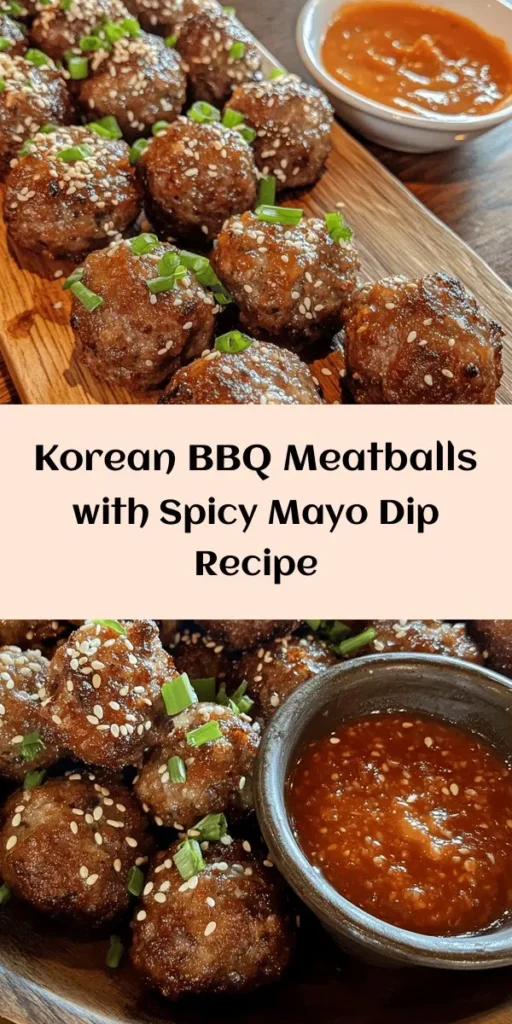Korean BBQ Meatballs with Spicy Mayo Dip are a delightful fusion of flavors that bring the vibrant tastes of Korean cuisine right into your home. This dish is not just a meal; it’s an experience that captures the essence of Korean BBQ, allowing you to savor the intricate flavors and unique textures that define this culinary tradition. Whether you’re hosting a gathering, preparing a family dinner, or simply enjoying a cozy night in, these savory meatballs are easy to prepare and bursting with umami goodness.
The combination of tender meatballs, infused with a blend of spices and herbs, paired with a creamy, spicy dip makes for an irresistible appetizer or main dish. As you bite into these juicy meatballs, you’ll experience a symphony of flavors that are sure to please even the most discerning palate. In this article, we will explore the ingredients that make this dish so special, the preparation steps involved in crafting the perfect meatballs, and the rich history behind this tantalizing dish. By the end, you’ll have all the knowledge you need to create a memorable meal that showcases the best of Korean cuisine.
Understanding the Key Ingredients
Exploring the Meatball Base
The foundation of any great meatball lies in its choice of meat. When it comes to Korean BBQ meatballs, you have a couple of options: beef or pork. Both meats bring their own unique characteristics to the dish.
Ground Meat Choices: Beef vs. Pork
Ground beef is a popular choice because of its rich flavor and higher fat content, which helps keep the meatballs moist and tender. On the other hand, ground pork offers a slightly sweeter taste and a softer texture, making it a fantastic option as well. Some recipes even suggest a blend of both meats, combining the best of both worlds for a truly unique flavor profile.
Role of Breadcrumbs in Texture
Breadcrumbs play a crucial role in achieving the perfect meatball texture. They help to bind the meat together while also absorbing moisture, ensuring that the meatballs remain juicy and tender as they cook. For an authentic twist, consider using panko breadcrumbs, which are coarser and create a delightful crunch on the outside of the meatballs.
Importance of Green Onions and Aromatics (Garlic and Ginger)
Green onions, garlic, and ginger are essential aromatics that elevate the flavor of the meatballs. Green onions add a fresh, mild onion flavor, while garlic and ginger contribute warmth and depth. Make sure to finely chop these ingredients to ensure they distribute evenly throughout the meat mixture.
Flavor Enhancers: Soy Sauce, Sesame Oil, and Brown Sugar
No Korean dish is complete without the umami boost provided by soy sauce. It adds a salty, savory depth to the meatballs. Sesame oil, with its nutty flavor, is another key ingredient that brings an authentic Korean taste to the dish. Additionally, a touch of brown sugar balances the savory elements and enhances the overall flavor, creating a deliciously complex taste.
The Heat Factor: Gochujang and Its Unique Flavor Profile
Gochujang, a staple in Korean cooking, is a fermented chili paste that adds a unique depth of flavor and a subtle heat to the meatballs. Its sweet and spicy profile is essential in achieving the authentic taste of Korean BBQ. Be sure to adjust the amount according to your heat preference, as this ingredient can vary in spiciness.
Delving into the Spicy Mayo Dip
While the meatballs are the star of the show, the spicy mayo dip is a crucial supporting character that enhances the overall dish.
The Creamy Base: Why Mayonnaise?
Mayonnaise serves as the creamy base of the dip, providing a smooth texture that complements the meatballs perfectly. Its richness is essential for balancing the heat from the gochujang and other spicy elements.
Balancing Spice with Gochujang
Similar to the meatballs, gochujang is the key to achieving the signature heat in the spicy mayo dip. The combination of mayonnaise and gochujang results in a dip that is both creamy and spicy, making it a perfect accompaniment for the flavorful meatballs.
The Role of Lime Juice and Honey in Flavor
To round out the flavors in the spicy mayo dip, a splash of lime juice adds brightness and acidity, cutting through the richness of the mayonnaise. Additionally, a drizzle of honey provides a touch of sweetness that balances the heat from the gochujang, creating a harmonious flavor profile that enhances the entire dish.
Preparation Steps for Korean BBQ Meatballs
Now that we have a solid understanding of the ingredients, it’s time to dive into the preparation steps for creating these delicious Korean BBQ meatballs.
Preheating and Initial Setup
Importance of Preheating the Oven
Before you start mixing your ingredients, it’s essential to preheat your oven to the right temperature. This step ensures that the meatballs cook evenly and develop a nice, crispy exterior. Aim for a temperature of around 400°F (200°C), which is ideal for baking meatballs.
Choosing the Right Baking Sheet and Lining Options
Opt for a sturdy baking sheet that can handle the heat and weight of the meatballs. You can line the baking sheet with parchment paper or aluminum foil to prevent sticking and make cleanup easier. If you prefer a crispier finish, consider using a wire rack placed on top of the baking sheet, allowing for better air circulation around the meatballs as they bake.
Creating the Meatball Mixture
Mixing Techniques for Optimal Flavor Incorporation
To create the meatball mixture, combine your chosen ground meat with breadcrumbs, chopped green onions, minced garlic, grated ginger, soy sauce, sesame oil, brown sugar, and gochujang in a large mixing bowl. Use your hands to gently mix the ingredients, being careful not to overwork the meat. Overmixing can lead to dense meatballs, so just mix until everything is evenly incorporated.
Tips for Seasoning to Taste
Before shaping the meatballs, it’s a good idea to taste the mixture for seasoning. You can cook a small patty in a pan to check the flavor and adjust the seasoning as needed. If you want a bit more heat, add more gochujang. For extra umami, a dash more soy sauce can elevate the flavor profile.
Shaping the Meatballs
Size Matters: Tips for Consistent Meatball Size
When it comes to shaping the meatballs, consistency is key. Aim for meatballs that are about 1 to 1.5 inches in diameter. This size allows for even cooking and ensures that they stay juicy inside. You can use a cookie scoop or your hands to form the meatballs, ensuring they are tightly packed but not overly compressed. This technique will help them hold their shape while baking.
Once you’ve shaped all the meatballs, place them evenly spaced on the prepared baking sheet or wire rack. This spacing allows them to cook evenly and develop a nice crust.
As you embark on this culinary adventure, remember that the joy of cooking comes not just from the final dish, but from the process itself. Embrace the vibrant flavors of Korean cuisine and enjoy the satisfaction of creating a delicious meal from scratch. In the following sections, we’ll dive deeper into the cooking process and the tips needed to elevate your Korean BBQ meatballs with spicy mayo dip to perfection.

Ensuring Proper Spacing for Even Cooking
When baking your Korean BBQ meatballs, it’s crucial to ensure proper spacing on your baking sheet. This allows for optimal airflow and even cooking, which are key factors in achieving the perfect meatball. Place the meatballs about an inch apart from each other. This spacing prevents them from steaming and ensures they get a nice crust on the outside while remaining juicy on the inside. For best results, use a rimmed baking sheet lined with parchment paper or a silicone baking mat. The parchment will help prevent sticking and make cleanup a breeze.
Baking to Perfection
Timing and Temperature for Ideal Meatballs
For tender and flavorful meatballs, preheat your oven to 400°F (200°C). This temperature is ideal as it allows the meatballs to cook quickly, locking in moisture while developing a delicious caramelization on the outside. Bake the meatballs for about 20 to 25 minutes, turning them halfway through to ensure an even cook. The key here is to monitor them closely in the last few minutes of baking, as oven temperatures can vary.
Signs of Doneness: What to Look For
To know when your meatballs are done, look for a few key indicators. First, they should be nicely browned on the outside and firm to the touch. If you have a meat thermometer, the internal temperature should reach at least 160°F (71°C) for ground beef or pork, ensuring they are safe to eat. Additionally, you can cut one meatball in half; it should be opaque throughout with no pink remaining. These signs will help you achieve perfectly cooked meatballs every time.
Crafting the Spicy Mayo Dip
Whisking the Ingredients Together
Now that your Korean BBQ meatballs are baking, it’s time to prepare the spicy mayo dip, which will bring a delightful kick to your dish. In a medium mixing bowl, combine ½ cup of mayonnaise, 1 tablespoon of gochujang (Korean chili paste), 1 teaspoon of rice vinegar, and 1 teaspoon of sesame oil. Using a whisk, blend these ingredients thoroughly until they are smooth and creamy. The gochujang will add a spicy, slightly sweet flavor, while the sesame oil brings a nutty richness that enhances the overall taste of the dip.
The Ideal Consistency for Dipping
The ideal consistency for your spicy mayo dip should be thick enough to adhere to the meatballs but smooth enough to drizzle. If you find the dip too thick, you can thin it out with a teaspoon of water or additional rice vinegar, adding a splash at a time until you reach your desired texture. Taste your dip and adjust the seasoning if necessary; a pinch of salt or a squeeze of lime juice can enhance the flavors even further.
Customizing Heat Levels: Adjusting Gochujang
If you prefer a milder dip, feel free to reduce the amount of gochujang to ½ tablespoon or even 1 teaspoon for a subtle heat. Conversely, if you like it spicy, bump it up to 2 tablespoons. This versatility allows you to tailor the dip according to your palate and the preferences of your guests, making it a perfect accompaniment to the flavorful meatballs.
Serving Suggestions and Pairing Ideas
Presentation Tips for Serving Meatballs
When it comes to serving your Korean BBQ meatballs, presentation can elevate the dining experience. Arrange the meatballs on a large platter or a wooden serving board for a rustic touch. Drizzle the spicy mayo dip over the meatballs or serve it in a small bowl in the center for guests to dip as they please. Consider garnishing with finely chopped green onions or cilantro for a fresh pop of color.
Garnishing with Sesame Seeds
For an added layer of flavor and visual appeal, sprinkle toasted sesame seeds over the meatballs just before serving. The nutty flavor of the sesame seeds complements the meatballs beautifully and adds a delightful crunch. This simple garnish can make your dish look restaurant-worthy and impress your guests.
Suggested Serving Dishes for a Festive Touch
For a festive dining experience, consider using colorful ceramic bowls or traditional Korean stoneware for serving. These dishes not only enhance the aesthetic appeal but also keep the meatballs warm. If you’re hosting a gathering, serving the meatballs as part of a larger spread with various dipping sauces and side dishes will surely delight your guests.
Pairing the Meatballs and Dip
Complementary Sides: Rice, Vegetables, or Salads
Korean BBQ meatballs pair wonderfully with a variety of sides that can balance the meal. Steamed rice—whether white, brown, or even cauliflower rice—makes for a perfect base. You can also serve them alongside sautéed vegetables like bok choy, snap peas, or bell peppers for a colorful and nutritious addition. Alternatively, a refreshing salad with a sesame vinaigrette can provide a crisp contrast to the rich flavors of the meatballs.
Beverage Pairings: Teas, Soju, or Light Beers
To complement your meal, consider serving traditional Korean beverages. A light, crisp beer can contrast beautifully with the spicy flavors, while soju—Korea’s beloved distilled spirit—is a classic pairing for BBQ dishes. If you prefer non-alcoholic options, a chilled barley tea or a refreshing iced green tea can cleanse the palate between bites and enhance the overall dining experience.
Cultural Context and Significance of Korean BBQ
The Evolution of Korean BBQ
Korean BBQ has deep historical roots, evolving over centuries from simple cooking techniques to the vibrant and flavorful cuisine we know today. Traditionally, meats were marinated with a variety of ingredients, including soy sauce, garlic, ginger, and sesame oil, to enhance flavor and tenderness. The communal aspect of cooking and sharing meals around a grill has always been a hallmark of Korean culture, emphasizing the importance of family and friendship.
Historical Roots of Korean BBQ and Meat Dishes
The origins of Korean BBQ can be traced back to the Goguryeo era (37 BC – 668 AD), where meats were cooked over open flames. This technique continued to evolve with the introduction of marinated meat dishes such as bulgogi and galbi, which became popular among the nobility and later among common people. Today, Korean BBQ has transcended borders, gaining international acclaim for its unique flavors and dining experience.
The Modern Popularity of Korean Cuisine Worldwide
In recent years, Korean cuisine has surged in popularity across the globe, driven by the rise of K-pop, K-dramas, and a growing appreciation for diverse culinary traditions. Dishes like kimchi, bibimbap, and of course, Korean BBQ have captured the hearts of food lovers everywhere. The accessibility of Korean ingredients and the rise of Korean restaurants have made it easier than ever to explore this flavorful cuisine at home or out on the town.
Korean BBQ in Social Settings
The Role of BBQ in Korean Culture and Communal Dining
Korean BBQ is not just a meal; it is a social event that brings people together. In Korea, dining is often a communal experience, where friends and family gather around a grill, cooking their food to their liking. This interactive style of dining fosters connection and conversation, making meals memorable occasions. The act of grilling meat at the table creates a lively atmosphere where everyone can participate.
The Importance of Sharing Food
Sharing food holds a special significance in Korean culture, symbolizing unity and togetherness. Dishes are often served family-style, encouraging everyone to take from communal plates. The Korean BBQ experience also emphasizes generosity; it’s common for hosts to prepare more than enough food to ensure guests leave satisfied. This warmth and hospitality are central to Korean dining, making it an enriching cultural experience.
Conclusion: Relishing the Experience of Korean BBQ Meatballs
Korean BBQ Meatballs with Spicy Mayo Dip are not just a meal; they are an experience that transports you to the heart of Korean culinary traditions. With a perfect blend of flavors and textures, this dish is sure to impress your family and friends. Each bite encapsulates the essence of Korean BBQ, combining savory meatballs with a creamy, spicy dip that excites the palate. Embrace the joy of cooking and savor the delightful tastes as you enjoy these delectable meatballs, whether at a casual family dinner or a festive gathering with friends. So, roll up your sleeves, gather your ingredients, and embark on this flavorful journey that celebrates the rich culture and history of Korean cuisine.



